Estimation of Actual Evapotranspiration along the Middle Rio Grande of New Mexico Using MODIS and Landsat Imagery with the METRIC Model
Abstract
:1. Introduction
2. Methods and Materials
2.1. Model Description
2.1.1. Incoming Shortwave Radiation (RS↓)
2.1.2. Calculation of Surface Albedo from MODIS
- (1)
- Calculation of at-satellite bidirectional (BD) reflectance from at-satellite radiance values assuming the absence of an atmosphere.
- (2)
- Calculation of at-surface reflectance from at-satellite BD reflectance values (i.e., application of atmospheric correction). The calculated at-surface reflectance is not entirely, but is predominately, BD reflectance, since it is calculated using information measured by the satellite sensor, which has a “directional” view. Whereas, at-surface solar radiation is a mixture of beam (i.e., directional) and diffuse (i.e., hemispherical) components, where the directional component is predominant under clear sky conditions.
- (3)
- Estimation of broadband surface albedo by integrating the at-surface band reflectances.
2.1.3. Outgoing Longwave Radiation
2.1.4. Sensible Heat Flux
2.1.5. MODIS Products Used for METRIC Processing
- MOD02HKM. Calibrated radiances (MOD02) for band 1–7 at 500 m resolution (HKM = half kilometer). In this product, MODIS bands 1 and 2 are aggregated to 500 m from their nominal 250 m pixel size to coincide with bands 3–7. The product is used to produce radiances and reflectances for bands 1–7. The conversion of MOD02HKM digital numbers (DN) to at-satellite radiance values is performed using the following equation:where Lt,b is at-satellite radiance in W/m2/sr/μm; Rads,b and Radoffs,b are the “radiance scales” and “radiance offsets” given for each band in the image metadata file. At-satellite reflectance is calculated using the following equation [16]:where Lt,b is at-satellite spectral radiance in band b (W/m2/sr/μm), and ESUNb is the mean solar exoatmospheric radiation over band b (W/m2/μm). Values of ESUNb for MODIS are included in Tasumi et al. [25]. Calculation of dr, cosθ follows procedures included in Allen et al. [16]. MOD02 is used to produce vegetation indices (NDVI, LAI), and surface albedo, which are utilized by several METRIC functions. Band 5 is commonly ignored due to systematic striping in this band.
- MOD11_L2. Land surface temperature (LST). This image product represents surface temperature at satellite overpass time. LST is used in the computation of outgoing longwave solar radiation, and sensible heat (H) via the Tsvs. dT function of METRIC.
- MOD03. Geolocation Fields. This file is needed to georegister the MOD02 and MOD11_L2 products. The file contains geodetic coordinates, solar zenith angle and sensor view angle for image overpass time. A maximum sensor view angle of less than 15°–20° is preferred in METRICM to avoid pixel deformation (bow tie effect) and fidelity loss (Figure 3). This is one reason why the 8- and 16-day products of MODIS are avoided with METRIC applications, because of difficulty in controlling the ingestion of information from days having large view angle.
- MOD35. Cloud mask product. This is a useful product that helps to mask areas of clouds that are difficult to identify due to the coarse spatial resolution of MODIS.
2.2. Study Area
2.3. Application of METRIC to the Middle Rio Grande Using MODIS and Landsat
2.3.1. Specific MODIS Products Used for the MRG Application
2.3.2. Hot Pixel Selection
2.3.3. Cold Pixel Selection
2.3.5. Reference ET
2.3.6. Water Balance for the Hot Pixel
3. Results
3.1. Evaluation of Consistency in Calibration Pixel Selection
3.2. Results from METRICM application
3.3. Comparison between Landsat and MODIS sApplications for Year 2002
3.4. Comparisons for Specific Locations
3.5. Impact of MODIS Resolution
3.6. Calculation of Monthly and Seasonal ET
3.7. Aggregation to the ET-Toolbox Grid
3.8. Uncertainty of ET Estimates
4. Conclusions
Acknowledgments
Conflict of Interest
References
- Kustas, W.P.; Norman, J.M. Use of remote sensing for evapotranspiration monitoring over land surfaces. Hydrol. Sci. J 1996, 41, 495–515. [Google Scholar]
- Bastiaanssen, W.G.M. Remote Sensing in Water Resources Management: The State of the Art; IWMI: Sri Lanka, 1998. [Google Scholar]
- Courault, D.; Seguin, B.; Olioso, A. Review on estimation of evapotranspiration from remote sensing data: from empirical to numerical approaches. Irrig. Drain. Syst 2005, 19, 223–249. [Google Scholar]
- Kalma, J.D.; McVicar, T.R.; McCabe, M.F. Estimating land surface evaporation: A review of methods using remotely sensed surface temperature data. Surv. Geophys 2008, 29, 421–469. [Google Scholar]
- Anderson, M.; Allen, R.G.; Morse, A.; Kustas, W.P. Use of Landsat thermal imagery in monitoring evapotranspiration and managing water resources. Remote Sens. Environ 2012, 122, 50–65. [Google Scholar]
- Crow, W.T.; Kustas, W.P.; Prueger, J.H. Monitoring root-zone soil moisture through the assimilation of a thermal remote sensing-based soil moisture proxy into a water balance model. Remote Sens. Environ 2008, 112, 1268–1281. [Google Scholar]
- Nagler, P.; Glenn, E.; Nguyen, U.; Scott, R.; Doody, T. Estimating riparian and agricultural actual evapotranspiration by reference evapotranspiration and MODIS enhanced vegetation index. Remote Sens 2013, 5, 3849–3871. [Google Scholar]
- Tang, R.; Zhao-Liang, L.; Tang, B. An application of the Ts-VI triangle method with enhanced edges determination for evapotranspiration estimation from MODIS data in arid and semi-arid regions. Remote Sens. Environ 2010, 114, 540–551. [Google Scholar]
- Yang, Y.; Shang, S.; Jiang, L. Remote sensing temporal and spatial patterns of evapotranspiration and the responses to water management in a large irrigation district of North China. Agric. For. Meteorol 2012, 164, 112–122. [Google Scholar]
- Bastiaanssen, W.G.M.; Menenti, M.; Feddes, R.A.; Holtslag, A.A.M. A remote sensing surface energy balance algorithm for land (SEBAL): 1. Formulation. J. Hydrol. 1998, 212–213, 198–212. [Google Scholar]
- Bastiaanssen, W.G.M.; Pelgrum, H.; Wang, J.; Ma, Y.; Moreno, J.; Roerink, G.J.; van der Wal, T. The Surface Energy Balance Algorithm for Land (SEBAL): Part 2 validation. J. Hydrol 1998, 212–213, 213–229. [Google Scholar]
- Bastiaanssen, W.G.M. Regionalization of Surface Flux Densities and Moisture Indicators in Composite Terrain: A Remote Sensing Approach under Clear Skies in Mediterranean Climates. 1995; p. 273. [Google Scholar]
- Ruhoff, A.; Paz, A.; Collischonn, W.; Aragao, L.; Rocha, H.; Malhi, Y. A MODIS-based energy balance to estimate evapotranspiration for clear-sky days in Brazilian tropical savannas. Remote Sens 2012, 4, 703–725. [Google Scholar]
- Jia, L.; Xi, G.; Liu, S.; Huang, C.; Yan, Y.; Liu, G. Regional estimation of daily to annual regional evapotranspiration with MODIS in the Yellow River delta wetland. Hydrol. Earth Syst. Sci 2009, 13, 1775–1787. [Google Scholar]
- Mu, Q.; Zhao, S.; Running, S. Improvements to a MODIS global terrestrial evapotranspiration algorithm. Remote Sens. Environ 2011, 155, 1781–1800. [Google Scholar]
- Allen, R.G.; Tasumi, M.; Trezza, R. Satellite-based energy balance for mapping evapotranspiration with internalized calibration (METRIC)—Model. ASCE J. Irrig. Drain. Eng 2007, 33, 380–394. [Google Scholar]
- Allen, R.G.; Tasumi, M.; Morse, A.; Trezza, R.; Kramber, W.; Lorite, I.; Robison, C.W. Satellite-based energy balance for mapping evapotranspiration with internalized calibration (METRIC)—Applications. ASCE J. Irrig. Drain. Eng 2007, 133, 395–406. [Google Scholar]
- Allen, R.G.; Tasumi, M.; Morse, A.; Trezza, R. A Landsat-based energy balance and evapotranspiration model in Western US water rights regulation and planning. J. Irrig. Drain. Syst 2005, 19, 251–268. [Google Scholar]
- Tasumi, M.; Trezza, R.; Allen, R.G.; Wright, J.L. Operational aspects of satellite-based energy balance models for irrigated crops in the semi-arid U.S. J. Irrig. Drain. Syst 2005, 19, 355–376. [Google Scholar]
- Tasumi, M.; Allen, R.G.; Trezza, R.; Wright, J.L. Satellite-based energy balance to assess within-population variance of crop coefficient curves. ASCE J. Irrig. Drain. Eng 2005, 131, 94–109. [Google Scholar]
- Allen, R.G.; Tasumi, M.; Trezza, R. Benefits from Tying Satellite-Based Energy Balance to Reference Evapotranspiration. In Earth Observation for Vegetation Monitoring and Water Management: Naples, Italy, 10–11 November 2005; D’Urso, G., Jochum, A., Moreno, J., Eds.; American Institute of Physics: College Park, MD, USA, 2005; pp. 127–137. [Google Scholar]
- Tasumi, M.; Trezza, R.; Allen, R.G. METRIC Manual for MODIS Image Processing Version 1.0 (April, 2006); University of Idaho R&E Center: Kimberly, IA, USA, 2006; p. 67. [Google Scholar]
- Allen, R.G.; Pereira, L.S.; Raes, D.; Smith, M. Crop Evapotranspiration: Guidelines for Computing Crop Water Requirements; Irrigation and Drainage Paper 56; United Nations FAO: Rome, Italy, 1998; p. 300. [Google Scholar]
- ASCE-EWRI. The ASCE Standardized Reference Evapotranspiration Equation; ASCE-EWRI Standardization of Reference Evapotranspiration Task Committee Report; ASCE: Reston, VA, USA, 2005; p. 216. [Google Scholar]
- Tasumi, M.; Allen, R.; Trezza, R. At-surface albedo from Landsat and MODIS satellites for use in energy balance studies of evapotranspiration. J. Hydrol. Eng 2008, 13, 51–63. [Google Scholar]
- Starks, P.J.; Norman, J.M.; Blad, B.L.; Walter-Shea, E.A.; Walthall, C.L. Estimation of shortwave hemispherical reflectance (albedo) from bidirectionally reflected radiance data. Remote Sens. Environ 1991, 38, 123–134. [Google Scholar]
- MODIS UCSB Emissivity Library. 2012. Available online: http://www.icess.ucsb.edu/modis/EMIS/html/em.html (accessed on 15 March 2012).
- Myneni, R.; Knyazikhin, Y; Zhang, Y.; Tian, Y.; Wang, Y.; Privette, J.; Morisette, J.; Running, S.; Nemani, R. MODIS Leaf Area Index (LAI) and Fraction of Photosynthetically Active Radiation Absorved by Vegetation (FPAR) Product (MOD15) Algorithm Theoretical Basis Document. Version 4.0; 1999. Available online: http://modis.gsfc.nasa.gov/data/atbd/atbd_mod15.pdf (accessed on 1 April 2008).
- Allen, R.G; Burnett, B.; Kramber, W.; Huntington, J.; Kjasersgaard, J.; Kilic, A.; Kelly, C.; Trezza, R. Automated calibration of the METRIC-Landsat evapotranspiration process. J. Am. Water Resour. Assoc 2013, 49, 563–576. [Google Scholar]
- Allen, R.G. Skin layer evaporation to account for small precipitation events—An enhancement to the FAO-56 evaporation model. Agric. Water Manage 2011, 99, 8–18. [Google Scholar]
- NASA Earth Observing System Data and Information System (EOSDIS); 2012. http://reverb.echo.nasa.gov/reverb (accessed on 15 January 2013).
- Hong, S.-H.; Hendrickx, J.M.H.; Borchers, B. Effect of scaling transfer between evapotranspiration maps derived from LandSat 7 and MODIS images. Proc. SPIE 2005, 5811, 147–158. [Google Scholar]
- Compaoré, H.; Hendrickx, J.M.H.; Hong, S.-H.; Friesen, J.; van de Giesen, N.C.; Rodgers, C.; Szarzynski, J.; Vlek, P.L.G. Evaporation mapping at two scales using optical imagery in the White Volta Basin, Upper East Ghana. Phys. Chem. Earth, Parts A/B/C 2008, 33, 127–140. [Google Scholar]
- US Bureau of Reclamation. ET Toolbox, Evapotranspiration Toolbox for the Middle Rio Grande. A Water Resources Decision Tool. 2008. Available online: http://www.usbr.gov/pmts/rivers/awards/ettoolbox.pdf (accessed on 15 January 2013).
- Allen, R.G.; Tasumi, M.; Robison, C.; Trezza, R.; Garcia, M. Exploration of ET Coefficients Derived Using MODIS Satellite-Based METRIC ETrF vs. Awards/ET-Toolbox Based ET Coefficients within the Middle Rio Grande Valley; University of Idaho Report; University of Idaho: Kimberly, IA, USA, 2008; p. 37. [Google Scholar]
- Hendrickx, J.; Allen, R.; Brower, A.; Byrd, A.; Hong, S.; Ogden, F.; Pradhan, N.; Robison, C.; Toll, D.; Trezza, R.; Umstot, T; Wilson, J. Benchmarking optical/thermal satellite imagery for estimation of evapotranspiration and soil moisture in decision support tools. J. Am. Water Resour. Assoc, 2013; submitted. [Google Scholar]
- Kamble, B.; Kilic, A.; Hubbard, K. Estimating crop coefficients using remote sensing-based vegetation index. Remote Sens 2013, 5, 1588–1602. [Google Scholar]

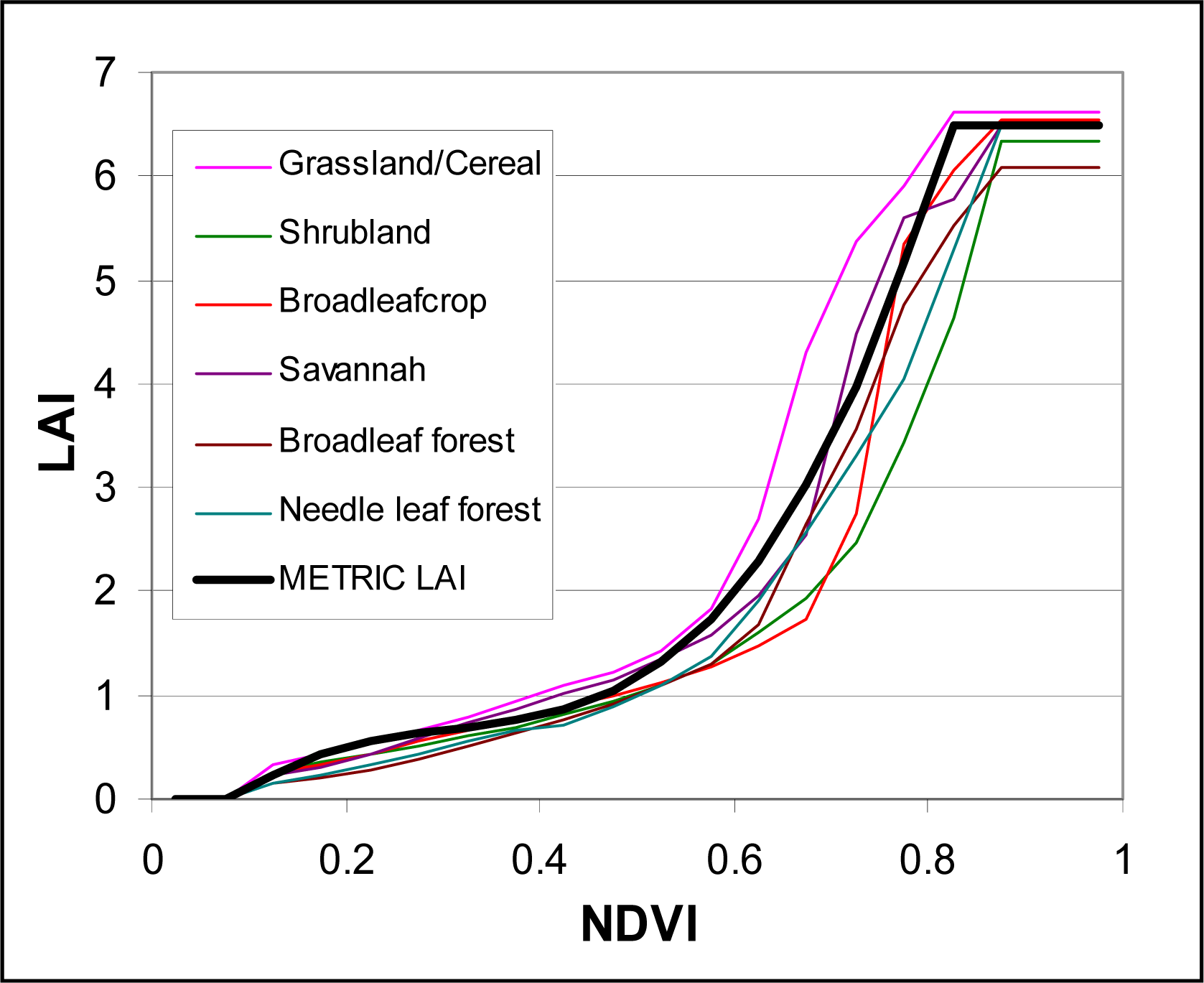

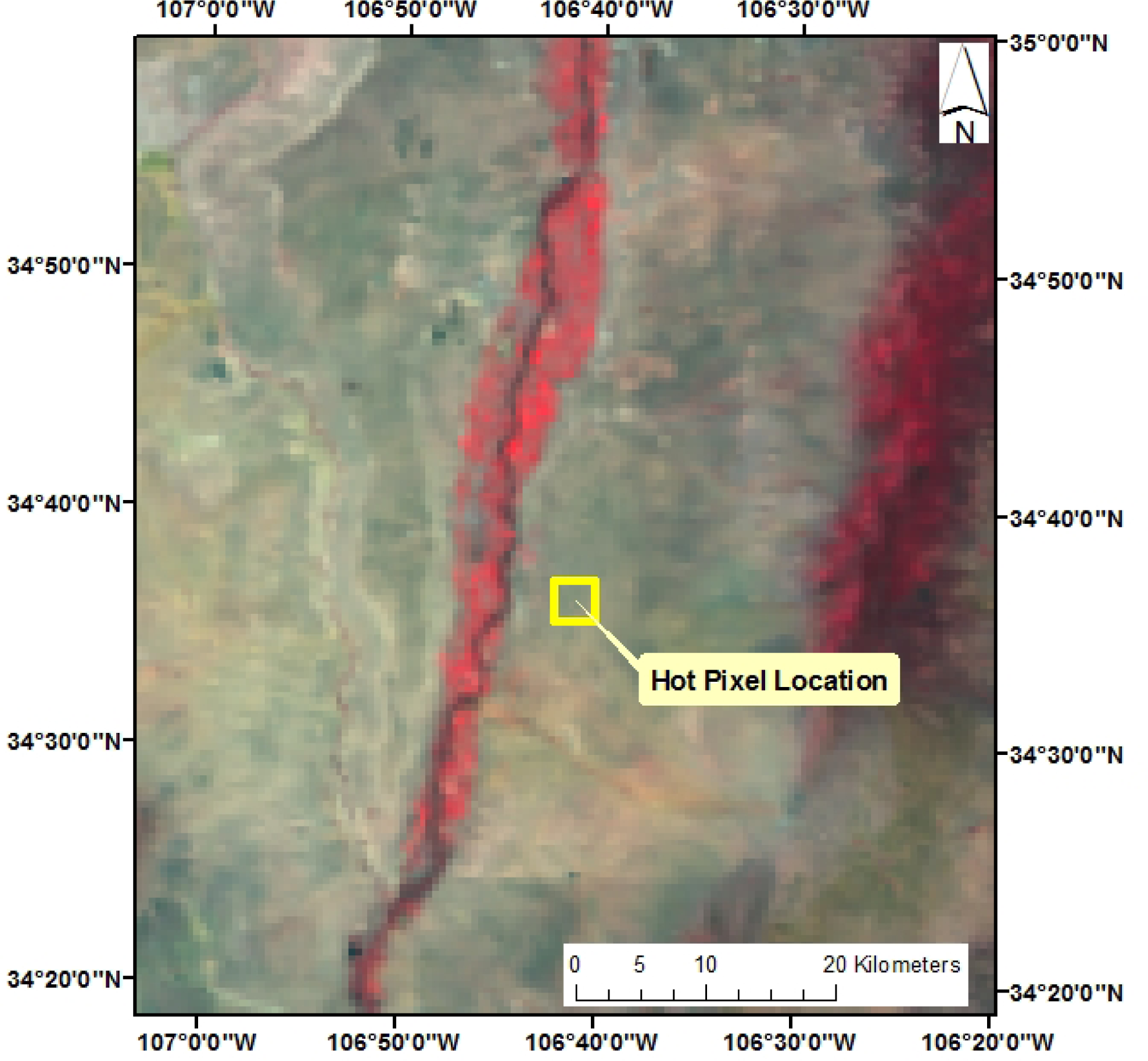





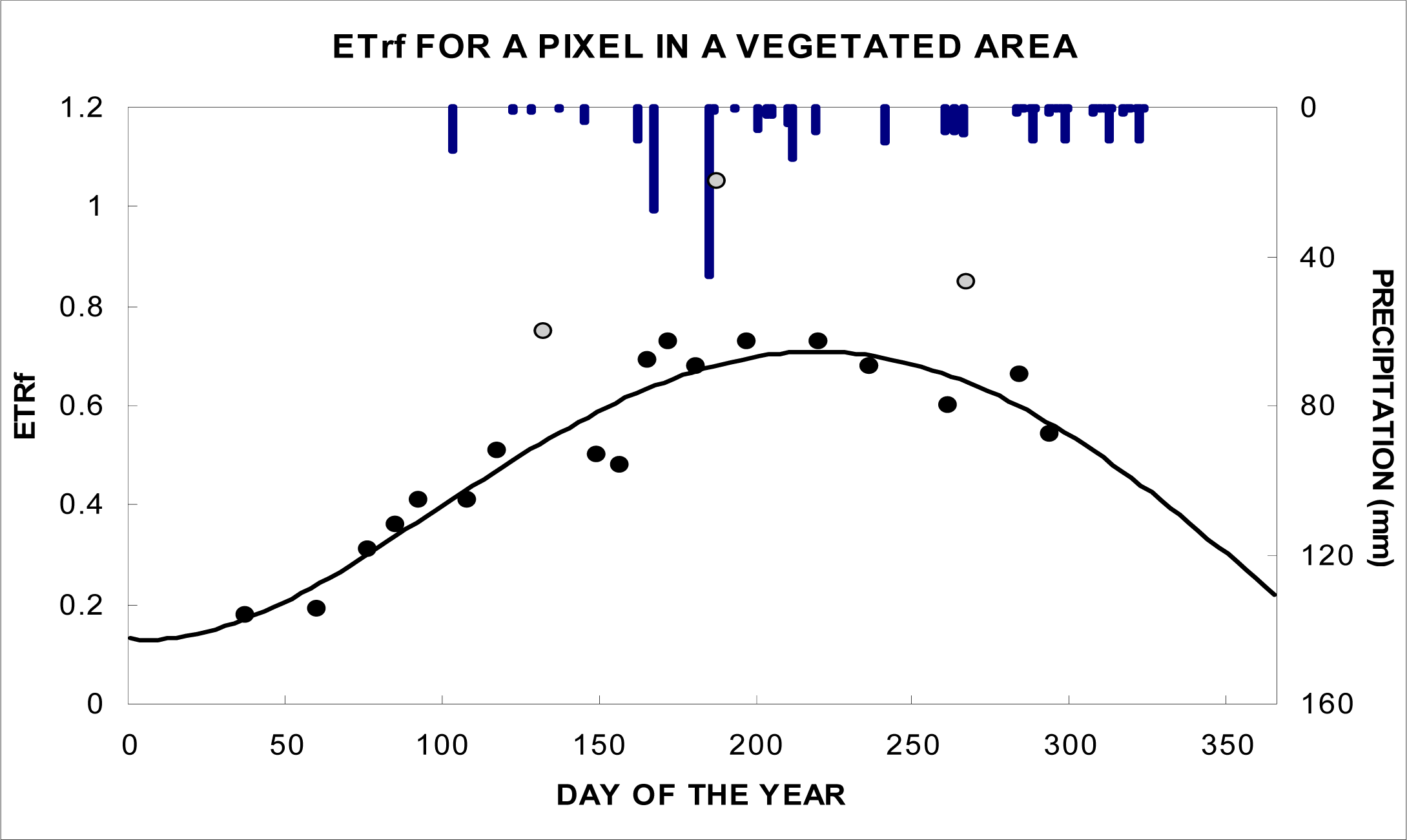


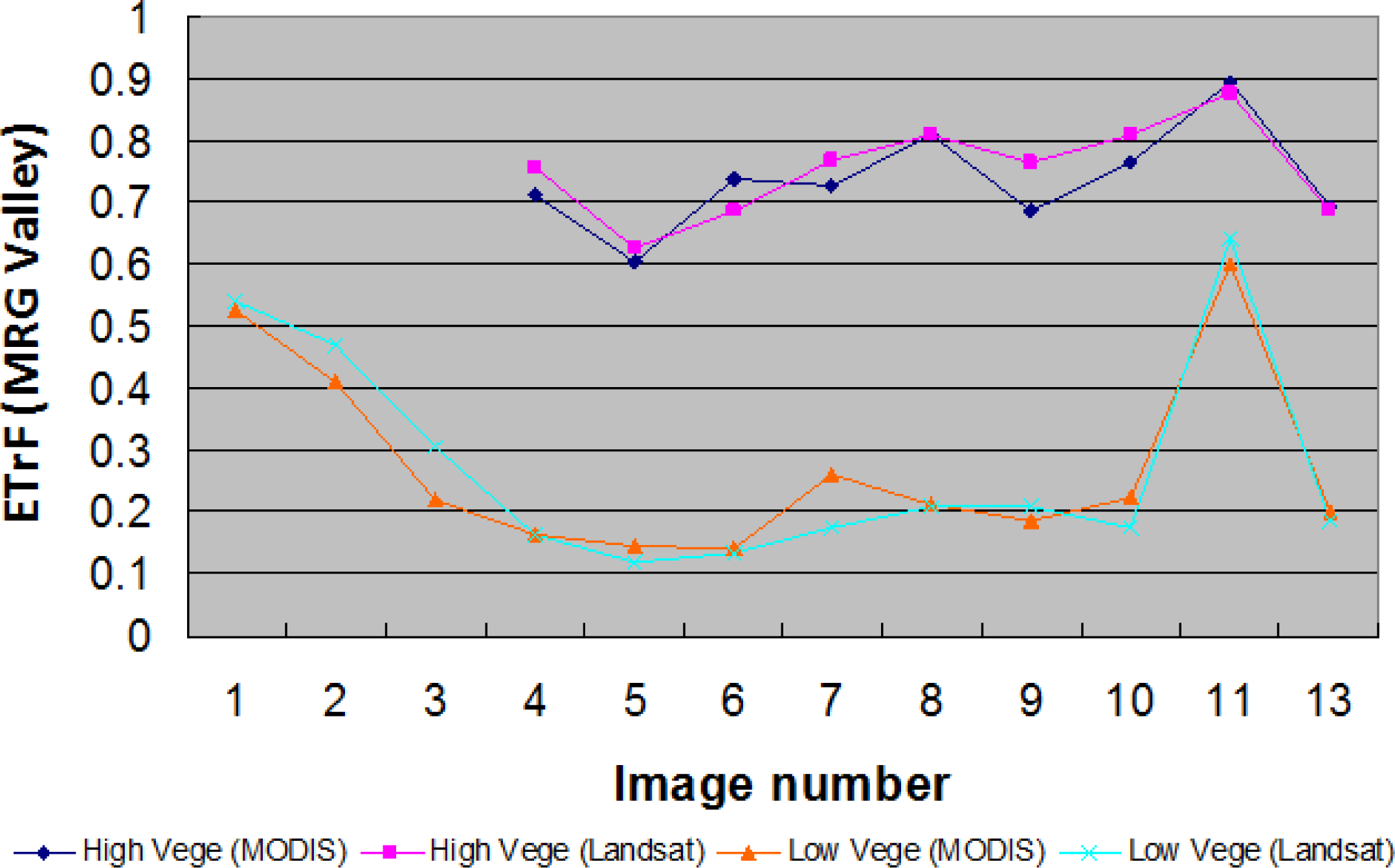
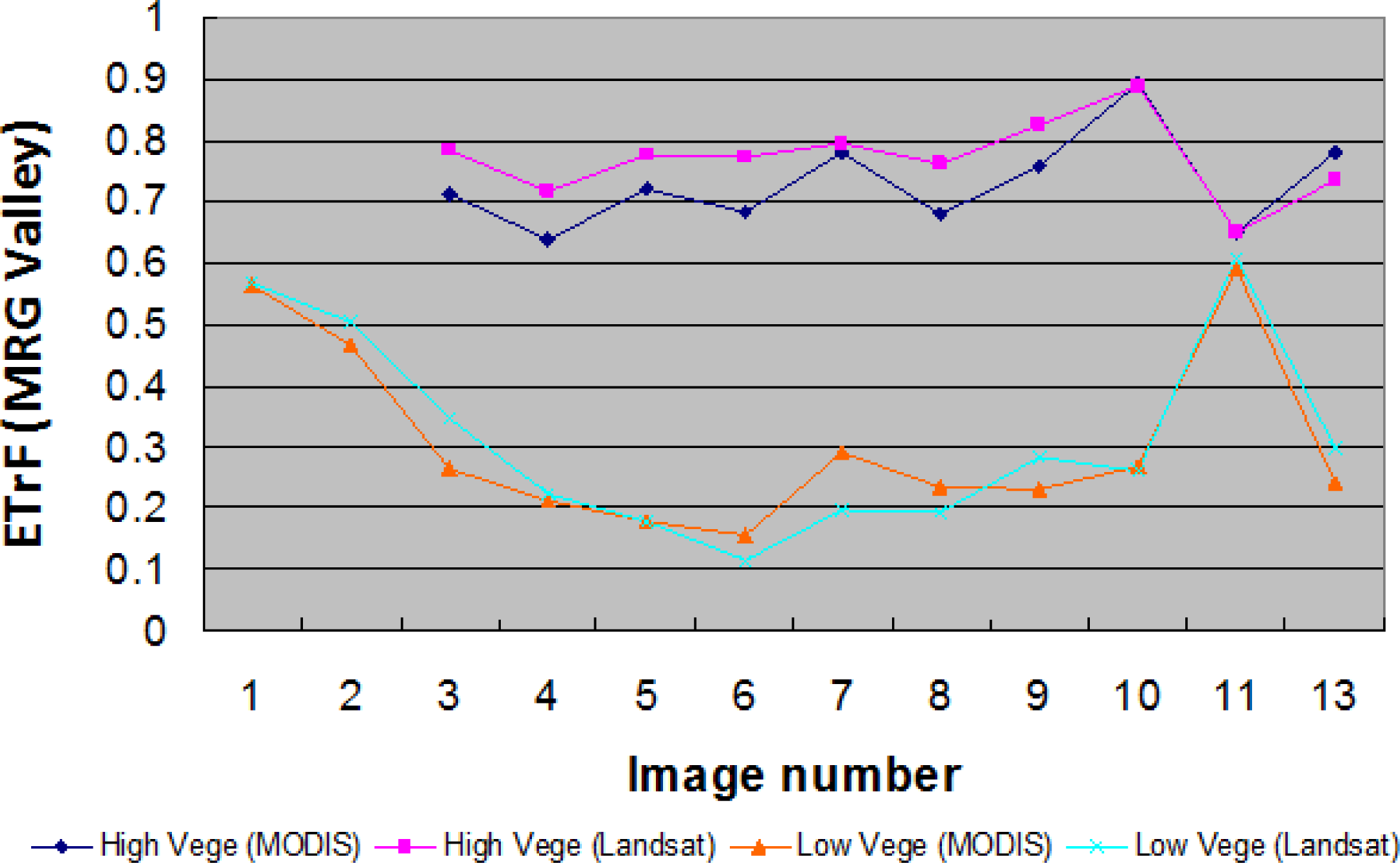

| Coefficient | Band 1 | Band 2 | Band 3 | Band 4 | Band 5 | Band 6 | Band 7 |
|---|---|---|---|---|---|---|---|
| C1 | 1.102 | 0.451 | 0.996 | 1.944 | 0.318 | 0.216 | 0.275 |
| C2 | −0.00023 | −0.00023 | −0.00071 | −0.00016 | −0.00022 | −0.00050 | −0.00031 |
| C3 | 0.00029 | 0.00055 | 0.000036 | 0.000105 | 0.00064 | 0.000800 | 0.004296 |
| C4 | 0.0875 | 0.0900 | 0.0880 | 0.0540 | 0.0760 | 0.0940 | 0.0155 |
| C5 | −0.0471 | 0.5875 | 0.0678 | −0.8870 | 0.7100 | 0.8006 | 0.7282 |
| Cb | 0.262 | 0.397 | 0.679 | 0.343 | 0.680 | 0.639 | −0.464 |
| Band | Band Limits (μm) | Applied Lob-UPb (μm) | Wb | Wb* |
|---|---|---|---|---|
| 1 | 0.620–0.670 | 0.593–0.756 | 0.215 | 0.215 |
| 2 | 0.841–0.876 | 0.756–1.053 | 0.215 | 0.266 |
| 3 | 0.459–0.479 | 0.300–0.512 | 0.242 | 0.242 |
| 4 | 0.545–0.565 | 0.512–0.593 | 0.129 | 0.129 |
| 5 | 1.230–1.250 | 1.053–1.439 | 0.101 | 0.000 |
| 6 | 1.628–1.652 | 1.439–1.879 | 0.062 | 0.112 |
| 7 | 2.105–2.155 | 1.879–4.000 | 0.036 | 0.036 |
| Image Number | MODIS | Landsat | Image Number | MODIS | Landsat |
|---|---|---|---|---|---|
| 1 | 1/14/02 | 1/14/02 | 8 | 7/25/02 | 7/25/02 |
| 2 | 3/3/02 | 3/3/02 | 9 | 8/10/02 | 8/10/02 |
| 3 | 4/4/02 | 4/4/02 | 10 | 8/26/02 | 8/26/02 |
| 4 | 5/6/02 | 5/6/02 | 11 | 9/20/02 | 9/20/02 |
| 5 | 5/22/02 | 5/22/02 | 12 | 10/22/02 | 10/22/02 |
| 6 | 6/7/02 | 6/7/02 | 13 | 11/7/02 | 11/6/02 |
| 7 | 6/16/02 | 6/15/02 |
© 2013 by the authors; licensee MDPI, Basel, Switzerland This article is an open access article distributed under the terms and conditions of the Creative Commons Attribution license ( http://creativecommons.org/licenses/by/3.0/).
Share and Cite
Trezza, R.; Allen, R.G.; Tasumi, M. Estimation of Actual Evapotranspiration along the Middle Rio Grande of New Mexico Using MODIS and Landsat Imagery with the METRIC Model. Remote Sens. 2013, 5, 5397-5423. https://doi.org/10.3390/rs5105397
Trezza R, Allen RG, Tasumi M. Estimation of Actual Evapotranspiration along the Middle Rio Grande of New Mexico Using MODIS and Landsat Imagery with the METRIC Model. Remote Sensing. 2013; 5(10):5397-5423. https://doi.org/10.3390/rs5105397
Chicago/Turabian StyleTrezza, Ricardo, Richard G. Allen, and Masahiro Tasumi. 2013. "Estimation of Actual Evapotranspiration along the Middle Rio Grande of New Mexico Using MODIS and Landsat Imagery with the METRIC Model" Remote Sensing 5, no. 10: 5397-5423. https://doi.org/10.3390/rs5105397




